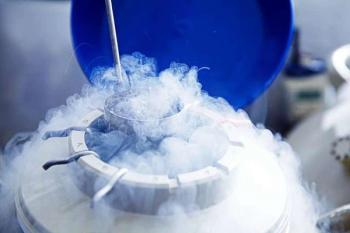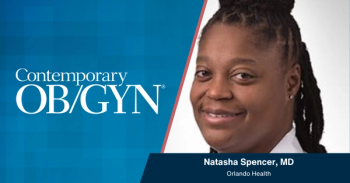
Prevention of Postoperative Adhesions
OBGYN.net Conference CoverageFrom the American Society of Reproductive Medicine, Orlando, Florida, October 22-24, 2001
Hans van der Slikke, MD: "It's October of 2001, and we're at the ASRM in Orlando. Next to me Dr. Mark Martens - welcome. Dr. Martens."
Mark Martens, MD: "Thank you."
Hans van der Slikke, MD: "Dr. Martens is a specialist in the prevention of adhesions. I want to discuss with you the history of the prevention of adhesions because we all know that one of the big complications from surgery is the adhesions, and it's especially dangerous or a problem in women who want to have children. Could you tell us what was done previously to prevent adhesions from the moment we recognize the problem?"
Mark Martens, MD: "Unfortunately, for most obstetrician-gynecologists adhesions have been a tremendous problem that we haven't had too much available to help us. What we did twenty or thirty years ago was exactly the wrong thing - as we had patients who had chronic pelvic pain and infertility, we operated on them and we found we created more adhesions. Fortunately, science moved ahead and tried to solve the problem, and we've had several devices or materials that we tried to use. One that was commonly used was dextran fluid, and that osmotically created ascites in the pelvis and flowed to the organs. Everyone thought it worked for a while and found out it was quite dangerous with the fluid changes, and it is no longer used. The barrier methods were then the next materials that were used, and the only one that really has been used quite frequently over the past ten years is the oxidized regenerated cellulose. It's been shown to be very effective in localized prevention of adhesions. It's usually used to wrap around ovaries or on sites where you have myomectomies. Several new devices have come and gone and last year at this meeting new data was presented on a gel-like material that was utilized in a double-blind comparative study in both Europe and the United States."
Hans van der Slikke, MD: "Last year you presented this study which was published last month in Fertility and Sterility, I believe."
Mark Martens, MD: "Right, in September of 2000 Fertility and Sterility." {
Hans van der Slikke, MD: "We will put a link into the interview. Can you tell us how this paper was set up?"
Mark Martens, MD: "The study that we participated in was a study looking at patients who desired fertility and needed a procedure where a laparoscopy was warranted. So a laparotomy was performed, adhesions were lysed or the procedure such a myomectomy was performed, and then the gel was administered versus 300 cc's of saline as the control agent. Six to twelve weeks later the patient had a second-look laparoscopy and the adhesions were scored based on the American Fertility Study Classification, and as presented in last year's poster, there was a significant reduction somewhere in the range of 40%-69% depending upon the procedure and depending upon if you're looking at new adhesions or reformation of adhesions."
Hans van der Slikke, MD: "Talking about the methodology, I think it's hardly possible to give this gel blind or what can we have as a placebo? How did you?"
Mark Martens, MD: "In the study it was difficult but they blinded it. The surgeon who did the original procedure could not be the surgeon that performed the second-look laparoscopy. Then just to make sure, they taped both procedures and had a third blinded person review the procedures. In my cases, 24-25 times or the majority of the time, there was no difference in the way the third person who was blinded rated either procedure as compared to the surgeon but when I went back in on the second look, I didn't know what was there."
Hans van der Slikke, MD: "No, so the procedure was set up properly. How were the results?"
Mark Martens, MD: "The results were very good and statistically significant. There were two groups; one was the control a saline group, and then one was the gel group. Then what they found was dependent upon if it was a myomectomy or a lysed adhesion then what the original procedure was."
Hans van der Slikke, MD: "But how big were the groups?"
Mark Martens, MD: "The groups were about 145 patients each; I think 143 and 142. Two arms for a total of 265 patients, the number was significant enough to get results with a strong enough power that the results were highly significant."
Hans van der Slikke, MD: "So this seems to be a good way to prevent adhesions."
Mark Martens, MD: "It prevented adhesions in many aspects, it reduced the severity of adhesions in others, and it decreased overall adhesions in several different sites since it is a gel and was able to coat the entire peritoneal cavity."
Hans van der Slikke, MD: "Does it depend on what kind of operations were done because we all know that a myomectomy is a very strong promoter of adhesions?"
Mark Martens, MD: "We kind of agree; we know that myomectomies cause a lot of adhesions and when you lyse previous adhesions from someone with endometriosis or a previous infection the chance of adhesion formation is high but the enrollment of patients was really based upon the study design. It was hard for us to consider doing a second-look laparoscopy unless the patient really needed that procedure. We know with myomectomy the studies have shown that a second-look laparoscopy that lyses some adhesions in a procedure where you know there's a high likelihood of having adhesions is probably helping fertility. We even had some patients get pregnant before the second-look which would be a great outcome though we didn't have the chance of a second-look laparoscopy on those patients."
Hans van der Slikke, MD: "I understand but you can suppose that there were not too many adhesions in these women."
Mark Martens, MD: "We hope not, and we don't suppose so."
Hans van der Slikke, MD: "What about this gel, what's in it, and what's your thought about it?"
Mark Martens, MD: "The gel in our study and the one that's currently under investigation is a hyaluronic based gel. Originally the concept was the hyaluronic acid that's used for the coating of knees and some other joints, however, that's rapidly absorbed so this gel is found with an iron molecule which gives it greater viscosity and makes its presence last much longer."
Hans van der Slikke, MD: "How long do you think it will be present?"
Mark Martens, MD: "It's hard to say, we know when we went back six weeks it was gone, and in the animal studies that they had performed earlier it seemed to be around about a week so it's somewhere in that period. It's a little more difficult than with the dextran materials in the past because you saw this mass of ascites, you can pick that up with ultrasound. This does not form an ascites so unless we took a look earlier, which we didn't in any case, we can't tell exactly but it looks like it hangs around for at least a week, maybe several."
Hans van der Slikke, MD: "Would this gel become commercially available or is it somewhere in the world already available?"
Mark Martens, MD: "It's currently available in Europe and in Canada, and it's currently under review by the Food and Drug Administration here in the United States."
Hans van der Slikke, MD: "So maybe in the near future we can also use it in the United States."
Mark Martens, MD: "We're hoping that but in the meantime, especially at meetings such as this, we have many international colleagues such as yourself, and several have experience with materials that are not available in the United States. So far their comments have been quite consistent with the results we had in our study."
Hans van der Slikke, MD:"Thank you very much, Dr. Martens, for this interview."
Mark Martens, MD: "Thank you."
Newsletter
Get the latest clinical updates, case studies, and expert commentary in obstetric and gynecologic care. Sign up now to stay informed.
















